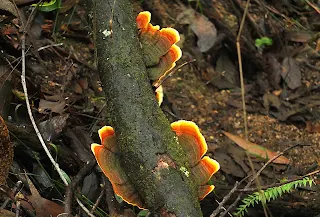To some, woodland and parkland cleared of
dead trees, logs and stumps etc, might be called aesthetically attractive, to
others such a scenario is akin to a desert!
In 2001, the Australian and New Zealand Environment
and Conservation Council prepared a report in which it stated that … ‘ongoing
removal of dead trees and woody debris on the ground caused by human activity
has been recognised as a factor contributing to loss of biological diversity’.
As much as 40% of Australian woodland wildlife
is dependent on dead wood material. Dead trees and logs play an essential role
in woodland, parkland, forest and wetland ecosystems.
Logs and dead trees have lots of hollows,
cracks and crevices of various sizes where animals may live, breed or shelter. In
Victoria more than 60 species of mammals and birds are directly reliant on
hollows – the list is expanded somewhat when the reptiles and invertebrates are
included. The loss of hollow bearing
trees from Victorian native forests is listed as a potentially threatening
process under the Flora and Fauna Guarantee Act.
 |
|
Many of our birds, mammals
and reptiles need
hollows in dead trees.
|
Hollows, cracks and crevices aside, dead
trees and logs play a vital role in maintaining a healthy ecosystem by
returning nutrients to the soil, insulation for the micro-organisms in the
soil, providing a barrier to erosion by wind and rain, etc. Many mosses,
lichens and fungi would not survive without dead woody material.
Every tree dies eventually but its
ecological value lasts long after the last leaf has fallen!
Further reading:-
Dead Wood and Wildlife – Dept of Conservation and Land Management WA.
Removal of dead wood and trees a key
threatening process – NSW Office of Environment and Heritage.
The value of dead wood to wildlife and agriculture
– DNRE Vic.
The Value of Habitat Trees – Land forWildlife Q.




No comments:
Post a Comment